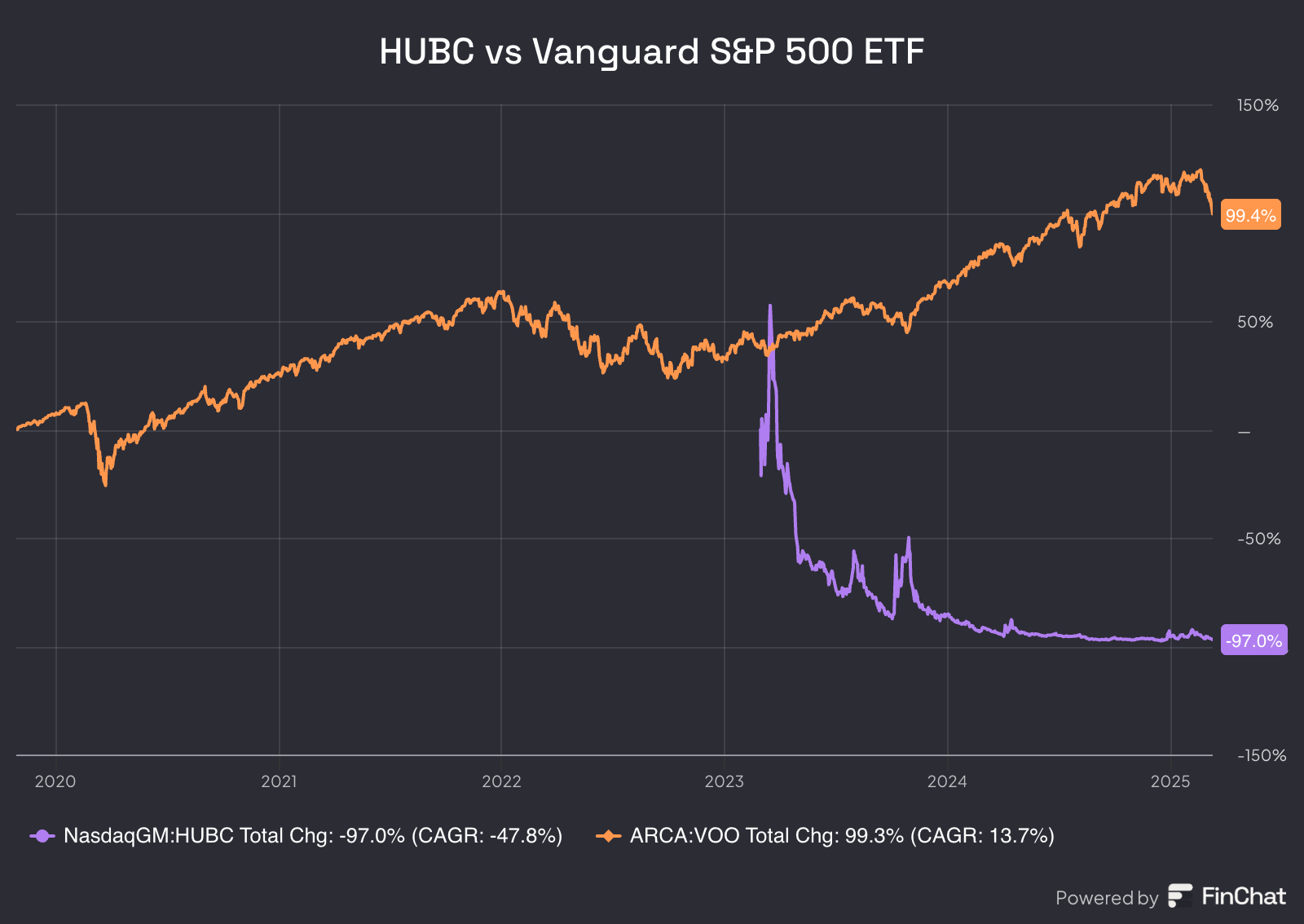From Cybersecurity to Shareholder Nightmare—What’s Happening at Hub?
Source: HUB Cyber Security Ltd.
Introduction
Cybersecurity often feels like a game of cat and mouse—hackers innovate, security firms respond, and the cycle continues. Hub Cyber Security Ltd. (Nasdaq: HUBC) claims to be a step ahead of the curve with its “zero-trust” technology and data-protection platform. But beneath the promising technology lie complex financials, significant shareholder dilution, and unresolved internal challenges. Here’s a closer look at what Hub does, how it manages capital, and why the market remains both exciting and daunting for this security upstart.
The Business Model: How Does HUB Make Money?
HUB Cyber Security generates revenue through its Secured Data Fabric (SDF) platform and legacy IT services. The primary revenue streams include:
Subscription Model
Hub’s main source of revenue comes from long-term subscription fees for its flagship Secure Data Fabric (SDF)—an all-in-one cybersecurity platform that can unify and secure sensitive data for large enterprises. Recurring contracts help smooth out revenue fluctuations and give the company a more predictable stream of income.Legacy IT Services
Alongside the SDF, Hub provides traditional IT and cybersecurity services to big-name clients like Boeing, Visa, and Lockheed Martin. While this legacy side is lower-margin compared to SDF subscriptions, it contributes a steady baseline of cash flow.
Acquisitions & PartnershipsHub has used acquisitions—such as Comsec Global and the more recent BlackSwan deal—to expand its product offerings and geographical reach. Each partnership aims to feed more clients into the SDF subscription model over the long haul.
The Bigger Picture: Cybersecurity Market Potential
Despite Hub’s challenges, cybersecurity itself is booming:
$271.91B in global cybersecurity spending by 2029, with the U.S. alone contributing $88.2B.
Confidential Computing—the concept behind Hub’s Secure Data Fabric—is expected to skyrocket from $9.04B in 2024 to $1.28T by 2034 at a blistering 64.1% CAGR.
If Hub can solidify its tech advantages and gain traction in regulated sectors (finance, healthcare, defense), it could capture a slice of this colossal market.
Management & Governance: A Cause for Concern?
CEO Noah Hershcoviz has a background in M&A and investment banking, alongside a modest ownership stake (0.8%). His skill set could be instrumental if Hub can streamline operations and deliver a path to profitability. But leading a publicly traded firm with these financial pressures is no small feat.
Capital Allocation: Chasing Growth or Burning Cash?
Pursuing Growth at All Costs
Hub is spending heavily on research, marketing, and acquisitions to stand out in a crowded cybersecurity field. This “grow first, profit later” mindset can be effective, but it has led to persistent net losses.Debt & Equity Issuance
Funding this growth strategy means borrowing money and issuing new shares—diluting existing shareholders. Hub recently secured $13.5 million in convertible notes to shore up settlements and operating capital. The big question is whether future expansions can pay off quickly enough to offset these obligations.
Key Question: Will today’s spending lead to a loyal customer base and a strong enough competitive edge to eventually outweigh the current financial burn? Or does the constant need for fresh capital signal deeper operational issues?
Valuation: Is the Stock Cheap—or Cheap for a Reason?
Current Ratios
Price-to-Sales (P/S): Around 1.3, which on paper looks low compared to fast-growing tech peers.
EV/Gross Profit: 16.3, reflecting investor caution since Hub remains unprofitable.
Dilution & Market Skepticism
The share count ballooned nearly fivefold since 2020, driving the stock price down about 97%. Heavy dilution often erodes trust, making investors wary of further capital raises. Coupled with net losses, negative margins, and uncertainty about turning profitable, Hub’s valuation is high-risk.
Bottom Line
These metrics suggest significant upside—if Hub can execute. Yet the negative earnings and financing needs keep many investors on the sidelines. It’s a classic “high-risk, high-reward” setup.
Balance Sheet: Can They Survive Tough Times?
Financial Stress
The company carries $82 million in debt, some of it already in default, and it regularly burns through cash. Although recent convertible notes help keep lights on, the auditors have questioned the company’s ability to continue as a going concern.
High Debt + Negative Cash Flow
Hub has roughly $82 million in debt, part of which is already in default. Operating cash flow remains negative, though the company is showing modest improvement in covering its interest expenses.
Settlements & Convertible Notes
Legal disputes and settlements have strained finances, though the recent $13.5 million funding deal helps offset near-term obligations. The structure of these convertible notes is “friendly” in that it defers cash outlays, but each conversion could dilute current shareholders further.
Liquidity Concerns
Auditors have raised doubts about Hub’s ability to continue as a going concern. In simpler terms: They question whether Hub can generate enough cash or secure financing to stay afloat without massive restructuring.
Source: Finchat HUBC vs Vanguard
This chart paints a stark contrast between HUB Cyber Security (HUBC) and the Vanguard S&P 500 ETF (VOO). While the S&P 500 has nearly doubled (+99.3%) since 2020, HUBC has collapsed by 97%.
HUBC’s relentless downtrend suggests severe dilution, financial struggles, and market distrust, whereas the S&P 500 continues its long-term wealth-building trajectory. This highlights the importance of investing in strong, resilient companies — HUBC remains a high-risk, speculative bet, while the broader market keeps delivering.
While HUB’s acquisition of BlackSwan aims to capture a growing $12.91 billion market, its cash burn rate and capital needs present a significant risk.
High Debt + Negative Cash Flow
Hub has roughly $82 million in debt, part of which is already in default. Operating cash flow remains negative, though the company is showing modest improvement in covering its interest expenses.
Settlements & Convertible Notes
Legal disputes and settlements have strained finances, though the recent $13.5 million funding deal helps offset near-term obligations. The structure of these convertible notes is “friendly” in that it defers cash outlays, but each conversion could dilute current shareholders further.
Liquidity Concerns
Auditors have raised doubts about Hub’s ability to continue as a going concern. In simpler terms: They question whether Hub can generate enough cash or secure financing to stay afloat without massive restructuring.
Risks: What Could Derail Hub’s Ambitions?
Ongoing Net Losses: Negative cash flow and losses in 2023 ($86.6M) and 2022 ($80M).
Debt Defaults: Missed payments or ballooning interest can threaten operations.
Nasdaq Compliance: If the stock dips below required thresholds, Hub risks delisting—further depressing liquidity and investor confidence.
Internal Controls: Weaknesses in financial reporting and past allegations of fund misuse present governance red flags.
Management Experience: Navigating U.S. public markets is new territory for some of Hub’s leadership team.
Final Thoughts: A Speculative Bet in a High-Stakes Market
Hub Cyber Security is a study in contrast: a potentially groundbreaking technology story shackled by financial strain and market skepticism. The cyber landscape is indeed massive and growing, and Hub’s Secure Data Fabric could be a compelling solution. Yet the risks—debt, dilution, negative cash flow, and lack of profitability—are downright daunting.
For investors, this boils down to risk tolerance. If Hub’s technology and strategy deliver, there’s upside in a market hungry for advanced data protection. But if you’re not prepared for the rollercoaster—complete with potential delisting drama and ongoing financing needs—this may be one to watch from the sidelines.
Check out our full in-depth analysis here: https://silvercrosscapital.substack.com/p/from-cybersecurity-to-shareholder?r=4fs22e
Disclaimer: This content is for informational purposes only and does not constitute investment advice. Always consult a qualified financial professional before making any investment decisions.




